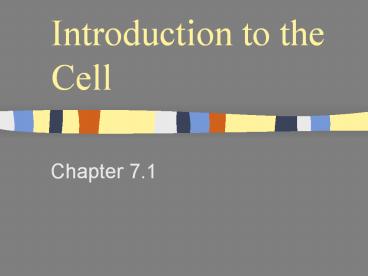Introduction to the Cell - PowerPoint PPT Presentation
1 / 32
Title:
Introduction to the Cell
Description:
Introduction to the Cell Chapter 7.1 Introduction to the Cell Cell- smallest unit of matter that can carry on all of the processes of life Hooke and Leeuwenhoek used ... – PowerPoint PPT presentation
Number of Views:169
Avg rating:3.0/5.0
Title: Introduction to the Cell
1
Introduction to the Cell
- Chapter 7.1
2
Introduction to the Cell
- Cell- smallest unit of matter that can carry on
all of the processes of life - Hooke and Leeuwenhoek used microscopes to see
first images of cells in the 1600-1700s.
3
The Cell Theory
- a. All living things are composed of cells
- b. Cells are the basic units of structure and
function in an organism (smallest living unit). - c. Cells come only from the reproduction of
existing cells (cells come from cells).
4
Cells Size
- Limited in size because of surface to area ratio
- If a cell gets too big the nutrients and wastes
do not have enough surface area to come into /
out of the cell
5
Shape
- A cells shape is usually associated with its job.
6
Internal Organization
- Cells contain many organelles
- Def cell component that performs specific
functions for the cell - Like mini organs
- Cell membranes surround cell and decides what
goes in and out of the cell. - Nucleus contains genetic information (DNA), which
controls the cell.
7
Eukaryotic vs. Prokaryotic
- Eukaryotic
- Cell that has membrane bound organelles
- More complex
- Plant and animal cells
- -YOU are a eukaryote!
- Prokaryotic
- Has membrane around entire cell
- No organelles
- No nucleus
- bacteria
8
Eukaryotic vs. Prokaryotic
9
Bill Nye Discovery of Cells
10
Organelles
- Inside the Eukaryotic Cell
- 7.2
11
Cell Membrane
- The lipid bilayer that surrounds the cell
12
Cell Membrane cont.
- Controls what enters/leaves the cell
- Selectively permeable allows some substances to
enter while not allowing others to enter - Sometimes have proteins integrated into the
layer, some are on either side of the bilayer
13
(No Transcript)
14
All cells have
- Cytoplasm-a jelly like substance that fills the
cell within the cell membrane. - Ribosomes- the cellular
- structure where proteins
- are made.
15
Nucleus
- Contains DNA, hereditary info.
- Surrounded by the nuclear membrane
- Also has a nucleolus where ribosomes are made.
- The cells brain.
16
Mitochondria
- Site of chemical reactions that produce ATP
(energy). - Have folded center to allow for more surface area
for production of ATP - Have their own DNA
- Many of them in the cell
17
Ribosomes
- Numerous some are free floating others are
attached to Endoplasmic Reticulum - Play a large role in the production of proteins
18
Endoplasmic Reticulum
- Act as highway for proteins and other substances,
has many different channels - Rough ER ribosomes make proteins, ER ships them
off - Smooth ER makes steroids, regulates calcium,
and breaks down toxins
19
Lysosome
- Uses enzymes to digest/break down organic
compounds, old cell parts and other materials
20
Golgi Apparatus
- Processes and packages cells proteins
21
Cytoskeleton
- Provides support and allows movement like a
humans skeleton.
22
Cilia and Flagella
- Cilia
- Found on outside of the cell
- Aid in movement
- Hair-like structures
- Cilia are short and come in large numbers
- Flagella
- Found on out side of the cell
- Aid in movement
- Hair-like structures
- Flagella usually come in 1-3.
23
(No Transcript)
24
(No Transcript)
25
(No Transcript)
26
Plant vs. Animal Cells
- Both plants and animals have more complex
eukaryotic cells. - However there are some differences in there
structure.
27
Plant Cells
- Have cell wall for structural support- like plant
bones - Has large vacuoles for storage of water and
toxins - Have Chloroplasts that convert light into
chemical energy
28
Animal Cells
- No cell wall, just a cell membrane.
- No chloroplasts.
- No vacuole.
29
Levels of Organization
- From Cells to Organisms
- 7.3
30
Multicellular Organization
- Cell
- Tissue
- Organ
- Organ System
- Organisms
31
Multicellular Organization
CellThe smallest unit of life. Tissue A group
of similar cells that are working together.
Examples Muscle tissue or bone tissue. Organ
Similar tissues organized into a structure with a
specific function. Examples Heart, bones,
liver.
32
Multicellular Organization
Organ system- Various organs working together to
carry out a major body function. Examples
digestive system, urinary system, reproductive
system. Organism-Any living thing that can carry
out life processes independently.































